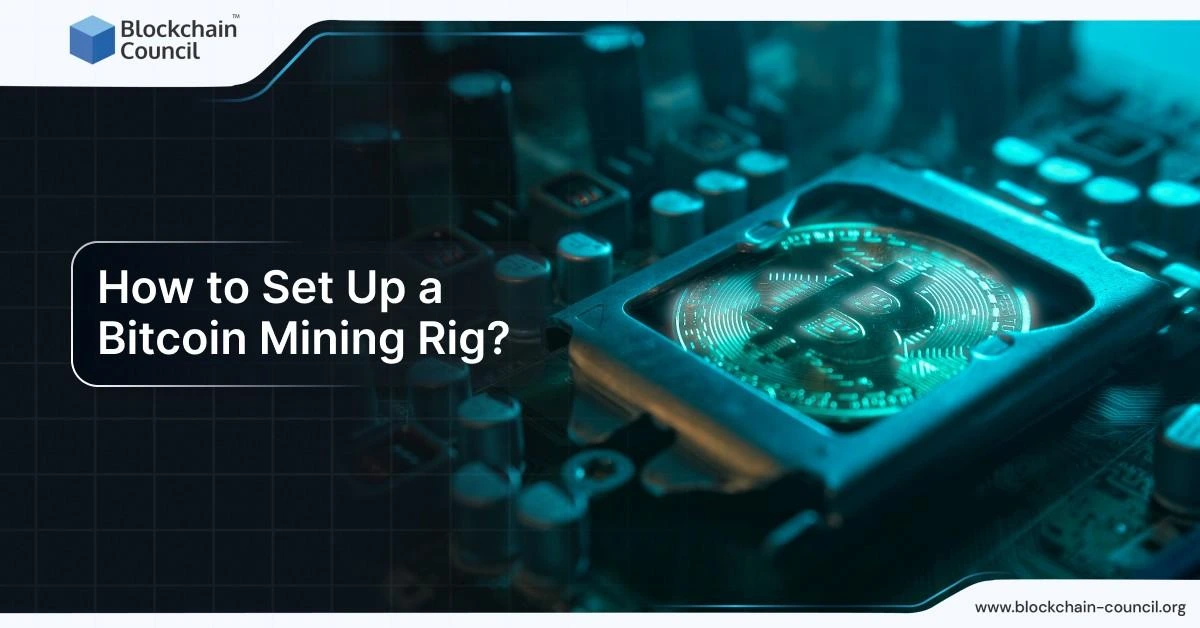
- Blockchain Council
- October 03, 2024
Setting up a Bitcoin mining setup might appear difficult initially, but with proper guidance, it’s completely manageable.
Basics of Bitcoin Mining Explained
Bitcoin mining involves verifying transactions on the Bitcoin blockchain. Miners utilize specific hardware to solve challenging mathematical problems, which secures the system and confirms transactions. In return, miners receive Bitcoin as a reward. The process demands considerable computing power, which is why building an efficient mining rig is crucial.
For those looking to enhance their knowledge and ensure they are well-equipped for the challenges of Bitcoin mining, the Certified Bitcoin Expert™ can be incredibly beneficial.
Gather the Necessary Components
Before beginning, you need to collect all the required parts. Here’s a list of items you’ll need:
- Motherboard: The base of your mining setup. Popular choices include the ASUS B250 Mining Expert and MSI H310-F PRO, both of which support multiple GPUs.
- Graphics Processing Units (GPUs): These are the main components of your setup. The amount of GPUs you require depends on your budget and the desired mining performance. If you’re just starting, consider beginning with one or two. When choosing GPUs, consider their hash rate (the speed at which they can solve the cryptographic puzzles) and power consumption.
- Power Supply Unit (PSU): The PSU provides power to all your parts. Make sure it has adequate wattage to support your GPUs. A 1200W Platinum-rated PSU usually works well. A high-quality PSU with at least an 80 Plus Gold rating is recommended to ensure efficiency and reliability.
- Central Processing Unit (CPU): While not as critical as GPUs, a modest CPU like an Intel 8th or 9th Generation will do the job.
- RAM: Mining rigs don’t require much RAM. A basic 4-8GB DDR4 module is usually enough to keep everything running smoothly.
- Storage: An SSD is preferred due to its speed and reliability, although an HDD will also work if you’re on a budget.
- PCIe Risers: These allow you to connect your GPUs to the motherboard.
- Cooling Solutions: Mining generates a lot of heat, so you need fans or a liquid cooling system to keep temperatures in check.
- Mining Frame: A frame or case to hold all your components together.
How to Set Up a Bitcoin Mining Rig? Step-by-Step Guide
Now that you’ve collected all the components, it’s time to assemble your mining setup. Follow these steps:
1. Get the Motherboard Ready
Place your motherboard on a surface that’s static-free. Attach the CPU by inserting it into the CPU socket and locking it in place. Apply thermal paste, then attach the CPU cooler. Connect the cooler to the motherboard’s power slot.
2. Install RAM
Insert the RAM module into the correct slot on the motherboard. Push down firmly until the module clicks into place.
3. Mount the Motherboard in the Frame
Secure the motherboard into your mining rig frame using screws. Make sure it’s properly aligned and mounted securely.
4. Install the Power Supply Unit (PSU)
Place the PSU close to the motherboard and attach the main 24-pin ATX power connector along with the 8-pin CPU power connector to the motherboard. Also, prepare additional power cables for the GPUs.
5. Install GPUs
Attach the GPUs to the rig frame using PCIe risers, which elevate the GPUs and improve airflow. Connect the GPUs to the motherboard and the PSU using the appropriate power cables.
6. Connect Storage
Connect your SSD or HDD to the motherboard using SATA cables (or directly through PCIe for NVMe SSDs). This will be used to store the operating system and mining software.
7. Set Up Peripherals
Plug in a monitor, keyboard, and mouse into the rig. These will be needed for the first setup and configuration.
Setting Up the Software
After assembling the hardware, it’s time to set up the software.
1. BIOS Configuration
Power on your rig and access the BIOS setup (typically by pressing Delete or F2). Make sure all your GPUs are detected, enable “Above 4G Decoding” if available, and set your PCIe speed to “Gen1” for stability.
2. Install Operating System
Install an operating system such as Windows or a specialized mining OS like Rave OS. Configure the OS to optimize performance, such as disabling unnecessary services and updates.
3. Install Mining Software
Download and install the mining software you prefer, like CGMiner, EasyMiner, or Kryptex. Configure the software by entering details like your Bitcoin wallet address and the mining pool details if you’re joining one. Configure it with the pool information (where you’ll mine with others) and wallet address (where your earnings will be sent).
4. Join a Mining Pool
Solo mining is not recommended for beginners due to the difficulty in earning consistent rewards. Instead, join a mining pool where several miners combine their computing power to boost their chances of earning Bitcoin. Pools such as Slush Pool or CK Pool are trustworthy choices. Set up your mining software to link to the pool, and you’ll start mining Bitcoin with others.
5. Optimize and Maintain Your Mining Rig
Optimization is key to ensuring your rig runs efficiently. This involves fine-tuning the power settings, overclocking your GPUs if necessary, and ensuring your cooling system is effective. Regular maintenance is also crucial—clean dust off your components regularly, monitor temperatures, and ensure all connections remain secure.
Conclusion
Assembling a Bitcoin mining rig requires knowing each component and its role in the mining process. Start by gathering the right parts, carefully assemble your rig, and then configure both the hardware and software for optimal performance. By joining a mining pool and regularly maintaining your rig, you’ll maximize your chances of earning Bitcoin effectively.
Whether you’re just starting out or looking to refine your setup, enhancing your knowledge through a cryptocurrency certification can provide you with the confidence and skills needed to succeed in this field.





































































 Guides
Guides News
News Blockchain
Blockchain Cryptocurrency
& Digital Assets
Cryptocurrency
& Digital Assets Web3
Web3 Metaverse & NFTs
Metaverse & NFTs
